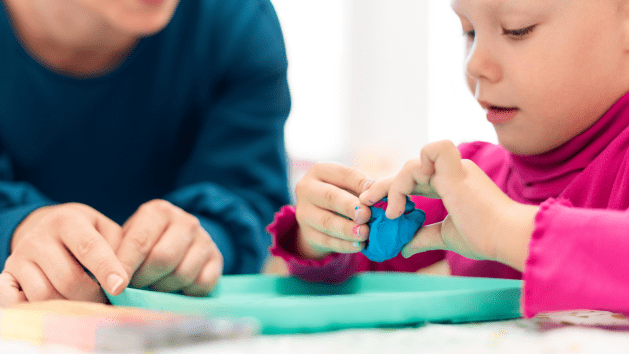
The occupational therapist’s role with children

What is occupational therapy?
Occupational therapy (occupational therapy in English) is an allied health profession focused on the well-being and active participation of individuals in their daily activities. The occupational therapist’s aim is to promote patients’ autonomy, improve their quality of life and facilitate their integration into society.
The WFOT (World Federation of Occupational Therapist) defines occupational therapy as: “a patient-centered health profession that focuses on promoting health and well-being through occupation. The primary goal of occupational therapy is to enable people to participate in the activities of daily living. Occupational therapists achieve this by working with individuals and communities to improve their ability to engage in the occupations they want, need or are expected to do, or by modifying the occupation or environment to better support their engagement in these activities.” (WFOT, 2012)
Pediatric occupational therapy
For our little ones, this means support to develop, reinforce or maintain the skills needed for everyday activities.
The occupational therapist can, for example, help a child improve coordination and motor skills to facilitate tasks such as dressing, eating, writing or playing. He or she can also intervene to support a child’s sensory development, help him or her better manage emotions, develop self-confidence and foster autonomy in a given context.
Who is pediatric occupational therapy for?
Most often, occupational therapists work with children presenting with a developmental disorder affecting their daily lives to a greater or lesser extent. This may be a DYS disorder (dyslexia, dyscalculia, dysgraphia, etc. ), a ADHD (Attention Deficit Disorder with or without Hyperactivity), a dysexecutive syndrome (disturbed development of executive functions), a motor or psychomotor disability, an autism spectrum disorder, etc.
✏ Note: beyond children, anyone encountering difficulties in carrying out their everyday activities, their occupations, whether due to a neurodevelopmental disorder, an accident, or age, can call on an occupational therapist.
The occupational therapist’s mission
Every child is unique, and the occupational therapist knows this well. During the occupational therapy assessment, he evaluates the child’s strengths and weaknesses, identifies obstacles and develops a tailor-made plan to meet his specific needs. In this adventure, he embarks with him parents, teachers and all the professionals who accompany the child (speech therapist, psychologist, etc.).
- Evaluation: the occupational therapist begins by assessing the child’s abilities and skills, analyzing his or her needs, lifestyle habits and any handicap situations he or she may face.
- Planning: safe, adapted environments are designed to facilitate daily activities at home, at school or, later, in the workplace. Technical aids and human assistance can be recommended to reinforce the child’s autonomy.
- Intervention: sets up activities to support the child and those close to him/her on a daily basis – re-educating gestures, adapting teaching aids, or setting up technical aids as a means of compensating for difficulties (IT tools, specific and adapted equipment, etc.), for example.
- Collaboration: ideally, the occupational therapist works hand in hand with doctors, paramedical professionals (speech therapist, AESH, etc.), social workers, and teachers for a global and comprehensive approach.
- Follow-up: he provides follow-up to adapt his support to the evolving needs of the child and his family.
💡 Babaoo’Tips
- Create a daily routine with fixed times for activities suggested by the occupational therapist. Regularity reinforces learning.
- To facilitate evaluation, keep a diary of your child’s daily activities. Note the times when he or she seems to be experiencing difficulties or successes. This will help the occupational therapist adjust his approach if necessary.
When to consult an occupational therapist for your child
If your child is showing some of the following signs, it may be time to consult a professional:
- Your child has difficulty performing daily activities such as dressing, eating or toileting.
- He encounters difficulties with coordination and fine motor skills: writing, buttoning his vest, tying his shoelaces; or gross motor skills: riding a bike, swimming…
- Your child has prehension problems: he holds his fork or pencil strangely, making certain everyday activities more complex.
- Your child seems uncomfortable or has trouble handling sensory stimuli. For example, he’s very selective about what he eats in relation to textures, he doesn’t like walking barefoot in grass or sand, he doesn’t like handling certain textures (mud, sand, play dough), clothing labels make him itch so much it’s unbearable, …
- Your child has difficulty organizing or planning activities.
- Your child has difficulty concentrating and staying attentive.
- Your child has difficulty managing emotions or behavior.
- Your child has trouble interacting socially with peers, avoiding play or having trouble sharing and waiting their turn.
- Your child shows signs of fatigue or excessive frustration when performing daily or school activities.
✏ Note: attention, no self-diagnosis! Prior consultation with a doctor is essential. The signs described above may have different causes, requiring the intervention of one or more healthcare professionals – and not necessarily or exclusively an occupational therapist.
The occupational therapist intervenes on medical prescription
Before making an appointment for an occupational therapy consultation, it will be necessary to seek the advice of a doctor. It is he or she who will direct you to the right remediation professional(s) (occupational therapist, speech therapist, psychomotricist, neurologist, neuropsychologist, etc.), whether to carry out a diagnosis and/or set up remediation sessions.
Preparing your child for his or her first occupational therapy session
Talk to your child about it as a positive experience. Explain that he’ll be meeting someone he’ll be teaming up with, who will help him discover new ways of playing and learning. Every step is an opportunity to celebrate small victories!
What to do in addition to occupational therapy sessions
Some activities to do at home to accompany it
The occupational therapist will almost certainly ask you to carry out activities with your child to complement and reinforce the work done in session, but also to establish routines and a regular framework of stimulation for your child. Here are a few examples, which in no way replace the recommendations of a healthcare professional 😉🩺
- Puzzles and construction games: they stimulate fine motor skills and hand-eye coordination. They also encourage problem-solving and logical thinking.
- Modeling dough workshops: shaping, rolling, and cutting modeling dough helps strengthen hand muscles and develops creativity.
- Motor course: create a course with cushions, chairs and objects to encourage your child to crawl, jump, and move in different ways. Change the course regularly to offer new challenges and keep your child’s interest.
- Sorting activities: use beans, buttons or beads for your child to sort by color, size or shape. This reinforces concentration and fine motor skills.
- Rhythm games: clap your hands, feet or use instruments to create rhythms. This helps develop coordination and a sense of rhythm.
How can occupational therapy help your child at school?
Occupational therapy helps your child develop key cognitive skills such as coordination, concentration and organization. Holding a pencil, taking notes, managing time or learning to use the IT tools available (computer, software, tablet)… The occupational therapist is there to adapt the work environment and equip the child to turn small school hassles into big victories.
Choosing an occupational therapist
The relationship is at the heart of this adventure. The occupational therapist seeks to weave a web of trust with your child and with you. At the first meeting, pay attention to the way he communicates: your child needs to feel at ease with him, confident. For your part, you need to feel reassured and supported in helping your little protégé to become more independent.
Recommendations are also a good way of finding an occupational therapist. Don’t hesitate to ask your doctor, other healthcare professionals or friends for advice. Word-of-mouth can often direct you to professionals who are recognized and appreciated for their expertise and human approach.
Don’t hesitate to ask your practitioner questions about his or her experience, areas of specialization, working methods and successes with other children.
Are occupational therapy sessions reimbursed by Social Security?
Occupational therapy sessions are only reimbursed by Social Security if they are carried out within a hospital or certain specialized establishments, such as medical-psychological centers (CMP). Sessions carried out by an occupational therapist in private practice are generally not reimbursed by the French health insurance system.
There are, however, options for obtaining financial support. Aids such as the AEEH (Allocation d’Éducation de l’Enfant Handicapé) may be available and awarded by the Maisons Départementales des Personnes Handicapées (MDPH), the Caisses Primaires d’Assurance Maladie (CPAM), and the Mutualité Sociale Agricole (MSA).
If in doubt, ask your doctor, and contact your Caisse Primaire d’Assurance Maladie (CPAM) and your complementary mutual insurance company to find out what assistance you may be eligible for.
The career path of an occupational therapist
To become an occupational therapist, specific training is required. The path begins with obtaining the Diplôme d’Etat (DE) d’ergothérapeute, essential for practicing this profession. Training lasts three years (bachelor’s degree level) and takes place at an occupational therapy training institute (IFE).
Studies are structured to provide future occupational therapists with a solid foundation of theoretical and practical knowledge, essential for meeting the varied needs of patients.
The curriculum is designed to be rich and comprehensive, preparing future professionals to meet the diverse and varied challenges they will encounter in their daily practice, working in the field with children, adults or the elderly, and collaborating with other health and welfare professionals.
The Babaoo recap!
Occupational therapy is a profession dedicated to supporting the development and well-being of children with special needs. A qualified and caring occupational therapist can make a significant difference to your child’s life, helping them overcome obstacles, gain independence and thrive in their daily activities. 🌟
You may also be interested in these articles



